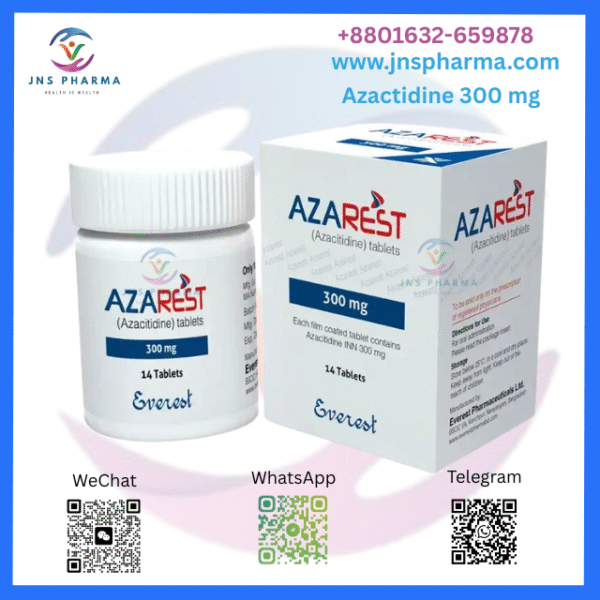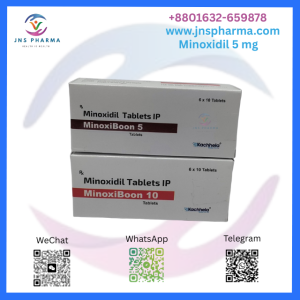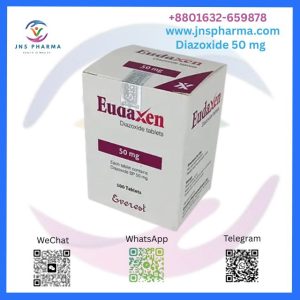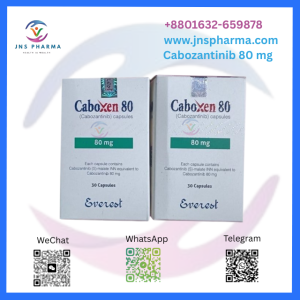Don't miss our holiday offer - up to 50% OFF!
Azarest 300 mg (Azactidine)
Azarest 300 mg is a medicine that contains Azacitidine, which is a chemotherapeutic medicine used primarily for the treatment of certain types of blood cancers. As a hypomethylating agent, Azacitidine is employed to serve as a crucial agent in the modulation of gene expression for those genes that regulate cell growth and cell death and thereby aid in the regulation of abnormal proliferation of blood cells. It’s used most generally to treat myelodysplastic runs (MDS), a group of conditions caused by abnormally produced or defective blood cells.
What is Azacitidine?
Azacitidine is a cytidine analog of pyrimidine nucleoside. It gets incorporated into DNA and RNA and induces dislocation of aberrant cell function and death in dysplastic or cancerous cells. One of its primary mechanisms is the inhibition of DNA methyltransferase, an enzyme that facilitates gene silencing by DNA methylation. Azacitidine leads tore-activation of excrescence suppressor genes through demethylation of DNA, which can inhibit or help growth of cancer cells.
The U.S. FDA approved Azacitidine originally in 2004 for treating MDS, and since also it has come a first- line remedy for a number of hematologic malice, particularly in cases who are infelicitous advocates for bone grafts or high-cure chemotherapy.
Indications and Uses of Azarest 300 mg
Azarest 300 mg (Azacitidine) is use to treat:
Myelodysplastic Runs (MDS) Including refractory anemia, refractory anemia with ringed sideroblasts, refractory anemia with redundant blasts, and habitual myelomonocytic leukemia (CMML).
Acute Myeloid Leukemia (AML) Particularly among aged cases who don’t have a chance for ferocious induction chemotherapy.
Habitual Myelomonocytic Leukemia (CMML) A lump that’s a combination of myelodysplastic and myeloproliferative diseases.
Azacitidine can enhance blood cell counts, reduce the need for transfusions, extend the duration of time to complaint progression to acute leukemia, and ameliorate overall survival.
Dosage and Administration
Depending on the therapeutic situation, Azarest 300 mg is typically give by intravenous infusion or subcutaneous injection. The authority cure depends on body face area (BSA) of the case, renal and hepatic function, and hematologic status.
A standard lozenge authority is
75 mg/ m ² per day for 7 successive days, followed by a rest period of 21 days to form a 28- day cycle.
It can be repeated every 4 weeks, and all the cases bear multiple cycles (minimum 4 – 6) to achieve conspicuous enhancement.
Lozenge adaptation can be done depending on the case’s response and side effects.
Note Azarest 300 mg is a reconstituted injectable medication, and the healthcare professionals have to follow strict medication and handling protocols.
Mechanism of Action
Azacitidine has two mechanisms of action:
Hypomethylation of DNA Azacitidine gets incorporate in the DNA of leukaemic cells and inhibits the exertion of DNA methyltransferase, performing in there-expression of genes that are suppressed and regulate cell growth and isolation.
Direct Cytotoxicity Formulated in RNA, it disrupts normal RNA function and protein conflation and causes death of fleetly dividing cancer cells.
With this combination of epigenetic reprogramming and cytotoxicity, azacitidine is useful in treating abnormal hematopoietic cells.
Side Effects and Precautions
Like most chemotherapy medicines, Azarest 300 mg is anticipated to beget significant side effects. Common and severe adverse effects include
Common Side Effects
Nausea and puking
Weakness
Constipation or diarrhea
Fever
response at the point of injection
Low blood counts( anemia, neutropenia, thrombocytopenia)
Serious Side Effects
Severe repression of bone gist
Because of a low white blood cell count
Liver or order damage
mislike (rash, swelling, briefness of breath)
Bruises or bleeding (caused by a low platelet count)
Cases entering azacitidine should have their complete blood count (CBC), liver function tests, and renal function covered regularly. The doctor must be report incontinently in case of any sign of infection, bleeding, or mislike.
Contraindications and Cautions
Azarest 300 mg isn’t recommend for cases who
Have a prove acuity to azacitidine or any of the constituents.
Are pregnant or getting pregnant (order D – may beget fetal injury).
Are lactating.
Caution is also suggest in
Cases withpre-existing liver or renal impairment.
Those with severe infection history or poor performance status.
Those entering other myelosuppressive treatments.
Drug Interactions
Although there have been no report direct medicine- medicine relations of significance with azacitidine, it could be synergistically potentiated by its myelosuppression whenco-administere with other chemotherapy agents, with attendant threat of bleeding or infection. All specifics, sauces, and supplements should be report to the doctor before starting remedy.
Storage and Handling
Azarest 300 mg should be store as direct by the manufacturer, generally.
In a refrigerator, between 2 and 8 degrees Celsius.
Reconstituted result needs to be use within a give time frame (generally within 1 hour at room temperature or 8 hours in cold storehouse).
It should be handle by only train healthcare labor force wearing defensive outfit due to its cytotoxic nature.
Conclusion
Azarest 300 mg (Azacitidine) is a crucial medicine in myelodysplastic runs, AML, and other affiliated hematological malice. Through targeting epigenetic along with cytotoxic pathways, it stabilizes normal blood cell product, extends the time to complaint progression, and optimizes survival in cases. Still, it needs careful dosing, close monitoring for toxin, and strong case- provider commerce to attain benefits.
As always, treatment decision- making on a complete discussion between oncologist and case, considering individual health status, relative benefit, and threat.







Reviews
There are no reviews yet.